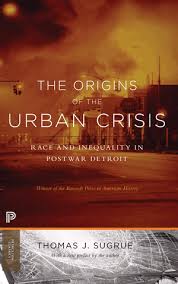Detroit’s History
On a recent road trip I had the opportunity to drive through Detroit. It had been almost twenty years since I last visited the city. I found it impossible to explore the city without engaging critically. The poverty and depopulation were striking. What happened? Was it culture or policy? How much did deindustrialization play? Poor leadership? Where were the buildings, houses and people? My imagination couldn’t stop wondering about what used to inhabit the open spaces.
 There are more than a few books and websites capturing images of Detroit’s ruins. Poverty tourism, though, is not the same thing as historical analysis. To understand Detroit, I strongly recommend Thomas Sugrue’s The Origins of the Urban Crisis: Race and Inequality in Postwar Detroit. It is an outstanding work, thought-provoking and comprehensive, well-deserving of its many prizes.
There are more than a few books and websites capturing images of Detroit’s ruins. Poverty tourism, though, is not the same thing as historical analysis. To understand Detroit, I strongly recommend Thomas Sugrue’s The Origins of the Urban Crisis: Race and Inequality in Postwar Detroit. It is an outstanding work, thought-provoking and comprehensive, well-deserving of its many prizes.
More traditional accounts of Detroit’s decline focus on the 1960s, the city’s riots, and white flight. Sugrue persuasively argues that the origins of the city’s troubles were present much earlier. He makes clear that the cause was not an inevitable result of market forces or the result of the breakdown of urban families. Sugrue has no truck with blaming the poor for being poor. Instead, he outlines how urban inequality is facilitated by mapping racial inequality on the city’s geography. It is played out in housing, in education, in healthcare, in employment, in crime, and in opportunity. “To a great extent in postwar America, geography is destiny,” Sugrue writes.
The book is organized into three large sections. In “Arsenal,” the economics and politics of the immediate post-war years in described. Sugrue focuses on the battles over segregation and integration. The city is large and featured many single family homes. White citizens of Detroit fought in the courts and in the streets to protect all-white neighborhoods. Blacks were forced into smaller areas with inferior and expensive housing stocks. Federal redlining through the FHA exacerbated segregation and pressure. Local electoral politics made things even worse, as white conservative politicians ran on race. Middle-class and working-class support for New Deal democratic liberalism collapsed in an onslaught of racism.
“Rust,” the second section, examines the difference between black and white Americans sometimes working in the same factories but always living differently in very different parts of the city. The last section, “Fire,” tracks the neighborhood associations and organizations that actively worked against integration and the civil rights of blacks. When Detroit erupted in riots and flames in 1967, we have a clear sense of the causes.
Collectively, Sugrue spells out how race and racism ate away at the possibility of integration and shared class interests, as well as the development of a healthy city. These sped Detroit’s economic collapse, which added to white flight. Things went from bad to worse in the ensuing years, as the tax base for the city shrank and the needs of its poor inhabitants increased. It is an extremely depressing story.
Detroit declared bankruptcy in 2013. The city has seen economic development in its downtown, but vast parts of the city are economic, educational, and socially depressed. Michigan’s unemployment rate in February, 2016 was 4.8% – in Detroit it is 11%. While there is money and hope in Detroit’s suburbs and the state as a whole, and a small movement in downtown, it is difficult to be optimistic about the city’s future. Racism casts a very long shadow.
David Potash